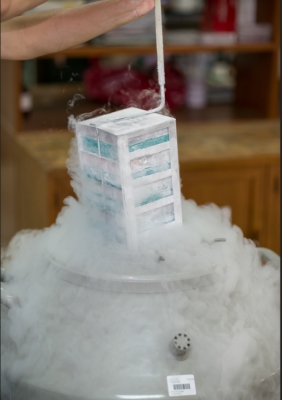Cord Tissue vs Cord Blood
Cord Tissue vs Cord Blood: What Are They And Which Are Their Differences?
Cord Tissue vs Cord Blood refers to the discussion about what is cord blood banking, something we discuss thoroughly in many articles, like this one, and cord tissue banking.
In our cord blood banking reviews, one of the categories for the distinction of the many cord blood banks reviewed, are these value added services, such as cord tissue banking, that provide an advantage in the comparison to the private bank that offers it.
Things are fast moving out of Sci-fi fantasies to realities in medicine. We are much closer to the days when we would be able to grow, regenerate many of our diseased organs. In fact, many are not even aware that it is already happening to some extent. A bone marrow transplant is not merely an organ transplant; it is about regenerating the blood tissues and immune cells. Cord blood banking and cord tissue banking are playing an essential role in the research, hence our title cord tissue vs cord blood; these cells are promising to provide treatment for diseases that have been considered incurable until this date, these technologies may significantly prolong our lifespan.
When you finish this article we will see that both cord blood and cord tissue are very important and the discussion cord tissue vs cord blood to exclude one of them will not have any sense.
From bone marrow to the embryonic cell, to cord blood and tissues
Researchers knew quite well by the mid of 20th century about the fantastic capabilities of specific organs to regrow and repair themselves, though they knew very little about how it happens. Researchers have been curious about why we lose the abilities to regrow, regenerate with age. They were interested in learning about how the fusion of ovum and spermatozoid, just two cells, leads to the formation of the adult body. They knew that if they could decode even few secrets of our early life, if they could decrypt those complex puzzles, they would be able to change the way diseases are treated.

Our blood cells have a lifespan of around three to four months, and thus researchers knew that blood tissues are some of the tissues that continue to regenerate during our whole lifespan. With research, scientists understood that bone marrow has some very primitive seed cells that under certain conditions can differentiate into red blood cells, various immune cells. Soon they also realized that these primitive cells from bone marrow might not only grow into the blood or immune cells, but they may also be used to repair specific organs. However, the bone marrow cells have the limitations as they could not differentiate into just any tissue cells. Thus they could not be used to grow or repair just any organ. Hence research for more universal or omnipotent seeds or stem cell started.
In order to find the seed cells or stem cells that could outgrow to just any organ or tissue, researchers started to look at the embryos. That is, they began to look for stem cell in human embryo created after the fertilization of the female egg. Luckily they were able to find that almost magical and omnipotent stem cell that could be grown to form just any organ. However, soon they found themselves at the dead end for two reasons, firstly, there is a limited supply of embryos, and secondly, there is a considerable number of ethical issues involved in experimenting with early phases of human life – that is experimenting with embryonic cells. Some types of studies of embryonic cells were banned in many nations.
Legal bans, ethical issues with embryonic stem cells forced researchers to look for other sources of stem cells; they wanted the sources that are as good as embryonic cells, they wanted the sources of stem cells that are not invasive or painful like bone marrow extraction. They gave attention to something that is part of early human life; they started studying placenta, umbilical cord, and its content. These are parts of our body, but they are rejected or thrown away immediately after the birth. Placenta and umbilical cord supply nutrition to a child in a womb, and they are not required by the child or mother after the birth.
On close examination and research regarding cord tissue vs cord blood, researchers found a number of useful cells in umbilical cord blood and cord tissue. They were amazed to see the variety of stem cells, surprised to know that these cells were quite primitive and thus unlike bone marrow cells can be used to grow more type of tissues. Therefore cells derived from cord tissues and blood can be used to treat a number of diseases. Best of all, it is a low-cost material, and its extraction is simple; it is something that is just thrown away in most cases. Thus suddenly after the discovery of stem cells in cord tissues and cord blood, they were transformed from waste material to something precious. Cord tissues and cord blood were suddenly worth of storage for future uses, having today cord tissue banking and cord blood banking, sometimes within the same company.
What are cord blood and cord tissues?
Cord blood and cord tissues are derived from almost the same source though they have quite a different content and properties, and thus different and varied possible medical usages. Cord blood as the name says is merely blood derived from the umbilical cord just after the childbirth; this blood has many immature stem cells that can be used to treat a variety of diseases through regenerative medicine.
We have already defined in many articles, for example this one, that cord blood is blood that is collected from the umbilical cord and placenta, blood that is rich in hematopietic stem cells, (HSCs), HSCs that can be used to form the immune system and blood. Cord tissue refers to the insulating material that surrounds the umbilical cord’s blood vessels. It is also known as Wharton’s jelly. Cord tissue is clear and jelly-like in appearance, containing epithelial and endothelial stem cells, as well as mesenchymal stem cells, of which it is a rich source. Because of the common sources is that in this article we compare them and discuss them together: cord tissue vs cord blood.
These stem cells found in the cord tissue can go on to form a human being’s cartilage, bone, skin, circulatory tissue, sensory organs, nervous system and more. Cord tissue is collected for these stem cells, which are then preserved to be potentially used to treat diseases and medical conditions in the future.
Cord tissues are the tissues located between the blood vessels of the umbilical cord and its outer covering or sheath. These tissues also have many stem cells. Moreover, these stem cells differ from those derived from the umbilical cord blood. It means that stem cells from cord tissues have entirely different usages in regenerative medicine. Therefore originally, the medical discussion was cord tissue vs cord blood.
Collection of both the cord blood and cord tissues is quick, except if there are nuchal cord complications, thanks to the usage of a collection kit provided by the public or private cord blood banking institution, and painless since both of these are extracted from materials that are rejected after the birth of the child. However, there are differences in a way these two objects are obtained. Cord blood is collected immediately after the childbirth from the umbilical cord and then sent for preprocessing and storage. However, cord tissues cannot be retrieved in the maternity ward or at the place of child’s birth. Hence, the doctor would usually cut the few inches of umbilical cord and store it in a special container, and then send it to a particular facility for tissue extraction. This difference in treatment originated the title of our article cord tissue vs cord blood that you are reading now.
So what is the primary difference? Cord Tissue vs Cord Blood
Though both of them have many similar kinds of stem cells, however, cord blood is mainly rich in Hematopoietic Stem Cells (HSCs), whereas cord tissue is rich in Mesenchymal Stem Cells (MSCs).
These stem cells have quite different properties and thus used to treat completely separate sets of diseases. Therefore HSCs are quite useful in treating the various illnesses of the blood, while MSCs are useful to treat structural ailments, diseases of connective tissues. Use of cord blood cells to treat different conditions started in 1988, and today, more than thirty years later, it has been used in more than hundred large clinical trials. Cord tissue stem cells were first used in 1995, and they have found much more extensive use and have been used in more than 200 clinical trials.
To fully understand and appreciate the differences and utilities of cord blood and cord tissue stem cells, we need to understand more about HSCs and MSCs.
Cord Tissue vs Cord Blood: Cord blood and extracted hematopoietic stem cells (HSCs)
As the name says, these cells primarily give rise to the various cells in our blood. They were first derived from the bone marrow and later from the mesoderm of embryo cells. In adult humans, few HSCs in the bone marrow are able to produce or replicate into more than half a billion blood cells each day. Hematopoietic stem cells give rise to red blood cells, immune cells like macrophages, monocytes, neutrophils, natural killer cells, T-cells, and so on.
Since hematopoietic stem cells can mature into just any kind of blood cells, they are usually used to treat the disorders related to the blood. They can be used to treat both the blood cancers and non-cancerous diseases of the blood.
Cancers commonly treated with HSCs- leukemias, lymphomas, neuroblastoma, myeloma, gliomas, and other solid tumors.
Non-cancerous diseases commonly treated with HSCs- various aplastic anemias, sickle cell anemia, thalassemia, immune deficiency syndrome, and autoimmune diseases.
Cord Tissue vs Cord Blood: Cord tissue and derived Mesenchymal stem cells (MSCs)
Though cord tissues are abundant in many kinds of cells, they are mainly stored for the MSCs. MSCs can replicate and differentiate into various cells of mesodermal origins. It means that they can differentiate into adipocytes, osteocytes (bone cells), and chondrocytes (cartridge cells). Researchers are also learning ways to differentiate them into some other tissues.
MSCs have some other unusual properties; they can migrate to the place of inflammation in the body and exert an anti-inflammatory effect, they can change the local immune responses. It means that they can be used not only to regenerate specific tissues but can also be used to treat various immune and autoimmune ailments. It says that they can be a part of both the regenerative medicine and disease therapy.
MSCs, due to their particular unique properties have received the huge attention from researchers in recent times. They are being extensively studied for use in various traumas and orthopedic injuries, liver diseases, autoimmune disorders, and for their role in altering the immune responses.
The future of the cord tissue vs cord blood discussion: Possibilities and uses of cord blood and cord tissues in the near future.
Furthermore, we must understand that the use of HSCs and MSCs is no more limited to the diseases mentioned above. Researchers have learned to genetically modify these cells and thus making them even more useful in various therapies; they have found the ways to turn them into pluripotent cells. It means that in future these cells would be used to treat just any kind of disease or regenerate just any organ, what increments the cord blood uses. With the speed of progress in regenerative medicine, one can confidently say that the future of medicine lies in the cell therapy.
Science is also improving in multiplying, differentiating stem cells, and they are also discovering other useful substances needed for the success of stem cell therapy. Thus researchers are finding the ways of multiplying the small number of HSCs or MSCs into a significant amount of similar cells. Further, they are investigating the means to make these cells to differentiate into various tissues. However, differentiation into specific tissues is not always enough. Even if we can find a way to grow lots of cartridges and joint tissues, it would be of no use if there will not be sufficient vascular growth in the region. Fortunately, with every passing year, researchers are reporting incredible achievements in the field. The field of research belongs to public banks and also to private banks as well.
Apart from the diseases of the blood and musculoskeletal system, cell derived from cord blood and cord tissue are finding use in the treatment of diabetes, kidney repair, spinal cord injury, Parkinson’s disease, muscular dystrophies, stroke, myocardials and much more. Many therapies are already in the last stages of clinical trials adding more spice to this cord tissue vs cord blood discussion and better perspectives for the near future.
At present there are certain legal hindrances, that nevertheless, with the better demonstration of the technology in various clinical trials, it is expected that soon the hurdles would be a thing of the past. Therefore less diferences cord tissue vs cord blood and more importance to both.
Cord tissue vs cord blood: Can cord blood and cord tissues both be stored for future use?
Yes, right after the birth of a child, one can go for both the cord blood and cord tissue banking. As per latest clinical data, it is expected that cord blood and tissue banking may help to save a life in more than 100 types of ailments.
Thus it is important to discover all the facts in the relation cord tissue vs cord blood about the cord blood and tissue banking, before the birth of the child, as the decision to store cord blood or tissue has to be taken immediately at the time of delivery. Most cord blood or tissue banks differ in the quality of services; thus it would be better to search for it in advance. Usually, one would have an option to store these tissues in public banks, from where anyone in need can benefit from them. Or one can save cord blood and cord tissue in the private bank, where it remains the property of the owner, however, these facilities come at a certain annual price.
Cord Tissue vs Cord Blood conclusions
Cord Tissue vs Cord Blood discussion: In conclusion, considering the progress in regenerative medicine or stem cell therapy, it can be said with confidence that decision to store cord blood and cord tissue through cord tissue banking would be a wise decision. It is the best investment one can do to ensure the healthy future of the family.
Therefore, consider important the category of the additional services provided by the private cord blood banks in this article and select cord blood banks that can store also cord tissue rejecting public cord blood banks.
In the future we will be changing the expression cord tissue vs cord blood by cord tissue AND cord blood.






